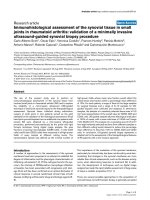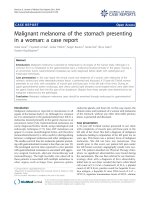Báo cáo y học: " Brown tumor of the maxillary sinus in a patient with primary hyperparathyroidism: a case report" ppsx
Bạn đang xem bản rút gọn của tài liệu. Xem và tải ngay bản đầy đủ của tài liệu tại đây (970.85 KB, 5 trang )
Case report
Open Access
Brown tumor of the maxillary sinus in a patient with primary
hyperparathyroidism: a case report
Efklidis Proimos
1
*, Theognosia S Chimona
1
, Dimetrio Tamiolakis
2
,
Michalis G Tzanakakis
1
and Chariton E Papadakis
1
Addresses:
1
ENT Department, Chania General Hospital, Chania, Crete, Greece
2
Department of Cytopathology, Chania General Hospital, Chania, Crete, Greece
Email: EP* - ; TSC - ; DT - ; MGT - ;
CEP -
* Corresponding author
Received: 6 March 2008 Accepted: 22 January 2009 Published: 6 July 2009
Journal of Medical Case Reports 2009, 3:7495 doi: 10.4076/1752-1947-3-7495
This article is available from: />© 2009 Proimos et al; licensee Cases Network Ltd.
This is an Open Access article distributed under the terms of the Creative Commons Attribution License (
/>which permits unrestricted use, distribution, and reproduction in any medium, provided the original work is properly cited.
Abstract
Introduction: Brown tumors are rare focal giant-cell lesions that arise as a direct result of the effect
of parathyroid hormone on bone tissue in some patients with hyperparathyroidism. Brown tumors
can affect the mandible, maxilla, clavicle, ribs, and pelvic bones. Therefore, diagnosis requires a
systemic investigation for lesion differentiation.
Case presentation: We present a 42-year-old Greek woman, with a rare case of brown tumor of
the maxillary sinus due to primary hyperparathyroidism. Primary hyperparathyroidism is caused by a
solitary adenoma in 80% of cases and by glandular hyperplasia in 20%.
Conclusions: Differential diagnosis is important for the right treatment choice. It should exclude
other giant cell lesions that affect the maxillae.
Introduction
Brown tumors are rare sequelae of hyperparathyroidism.
The lesions localize in areas of intense bone resorption,
and the bone defect becomes filled with fibroblastic tissue.
These tumors have a brown or yellow hue [1]. Brown
tumors arise secondary to both primary and secondary
hyperparathyroidism, and have been reported to occur in
4.5% of patients with primary hyperparathyroidism and
1.5 to 1.7% of those with secondary disease [1].
Hyperparathyroidism is frequently caused by the develop-
ment of a parathyroid adenoma and less often by
hyperplasia or a carcinoma. Some parathyroid adenomas
and hyperplasias are familial (5% of cases), and others are
part of multiple type I, IIa, and IIb endocrine neoplasias [2].
In a review of 220 patients, Rosenberg and Guralnick
found that 10 patients (4.5%) had a mass involving one or
both jaws as their presenting complaint [3]. Brown tumors
are more commonly seen in the mandible than in the
maxilla [1]. The reported prevalence of brown tumors is
0.1%. The disease can manifest at any age, but it is more
common among persons older than 50 years, and is three
times more common in women than in men [2].
Page 1 of 5
(page number not for citation purposes)
Most patients with hyperparathyroidism are asympto-
matic. Hypercalcemia is often discovered incidentally
during routine laboratory testing; hypoph osphatemia
and increased alkaline phosphatase levels in blood may
also be seen [2]. Any of the skeletal bones may be affected,
including the cranio-maxillofacial ones. Brown tumors
may be the first clinical sign of hyperparathyroidism.
Brown tumors are a localized form of fibrous-cystic osteitis
found in the prese nce of hyperparathyroidism [1,2].
Histologically, brown tumors are made up of mono-
nuclear stromal cells mixed with multinucleated giant
cells, among which recent hemorrhagic infiltrates and
hemosiderin deposits (hence the brown color) are often
found [3]. Whenever a round, radiolucent, and bone-
expanding lesion in the facial bones of a patient with
hyperparathyroidism is presented, a brown tumor must be
considered to be the most likely diagnosis [1,2]. However,
when the same type of lesion is found in patients without
hyperparathyroidism, a more complex differential diag-
nosis procedure must be followed [2,3].
Case presentation
A 42-year-old Greek woman was referred to the Depart-
ment of Otolaryngology of Chania General Hospital,
complaining of facial pain and deformity, and a radio-
graphic finding of a round, radiolucent, and osteolytic,
bone-expanding lesion in the anterior part of the right
maxillary sinus with invasion of the adjacent floor of the
orbit, anterior ethmoids and nasal cavity (Figures 1 and 2).
There was no family history of peptic ulcer, parathyroid
disease, or any other endocrinopathy. There was no history
of increased thirst, urinary frequency, constipation, weight
loss, urolithiasis, fracture, peptic-ulcer, use of vitamin or
calcium supplements, Paget’s disease, exposure to ionizing
radiation or industrial toxins, or use of tobacco or alcohol.
On physical examination, the patient appeared well. Her
head and neck were normal; no cervical masses were
palpated. Her lungs, heart, breasts, and abdomen were
normal, as was her urine. Hematocrit was 39.8%; white-
cell count was 6800/µL, with a normal differential count;
platelet count, prothrombin time, and partial-thrombo-
plastin time were normal. Rigid nasal endoscopy, with a
0
0
endoscope, revealed medialization of the right lateral
nasal wall with no signs of mucosal alteration.
Under general anesthesia, an excision biopsy was
performed using the Caldwell-Luc approach. The mass
had a submucosal origin from the floor of the orbit,
infiltrating the lateral nasal wall, with a diameter of
approximately 2 cm. The mucosa over the mass was intact
and after its excision, erosion of the floor of the orbit was
detected with prolapsed periorbital fat. The opening was
repaired with an underlay application of dura tissue which
was immobilized with tissue glue. Histological sections
showed a lesion with regions of discrete bone resorption
with osteoclast activity, areas with newly formed bone
tissue, and a loose fibrillar matrix with deposits of
hemosiderin (Figure 3). Multinucleated giant cells were
also found in the lesion (Figure 3). A giant cell lesion was
diagnosed, with a brown tumor among the possible
causes.
Figure 1. Axial computed tomography of the paranasal
sinuses showing a round osteolytic lesion of the right
maxillary sinus.
Figure 2. Coronal magnetic resonance imaging of the
paranasal sinuses showing a round, bone-expanding lesion in
the anterior part of the right maxillary sinus with invasion of
the adjacent floor of the orbit, anterior ethmoids and nasal
cavity.
Page 2 of 5
(page number not for citation purposes)
Journal of Medical Case Reports 2009, 3:7495 />Blood tests after histology demonstrated elevated calcium
(13.3 mg/dL) and parathyroid hormone (PTH) concentra-
tions (920 pg/mL). Phosphorus was 1.9 mg/dL, alkaline
phosphatase was 227 U/L (normal range 30 to 100 U/L);
the urea nitrogen, creatinine, glucose, bilirubin, uric acid,
protein, albumin, globulin, serum aspartate aminotrans-
ferase, and thyroid-stimulating hormone levels were all
normal. Sodium was 139 mmol, and potassium was
5.5 mmol. Carcinoembryonic antigen was less than 1 µg/L,
and serum immunoelectrophoresis was normal. The
concentrations of IgG, IgA, and IgM were normal. This
suggested the diagnosis of primary hyperparathyroidism
initially manifesting as a brown tumor of the maxilla.
Postoperative explorations with magnetic resonance ima-
ging (MRI) scans and gadolinium infusion confirmed the
existence of an underlying parathyroid adenoma in the
upper left parathyroid gland as the cause of the condition.
The patient was referred to the outpatient clinic of the
Department of Endocrinology, at the University Hospital
of Crete, for examination of her parathyroid function.
Discussion
Various anatomopathological entities, both benign and
malignant, can appear as bone-expanding or lytic lesions
in the facial bones [4]. In the case of a lytic region of the
jaw bones, the most likely diagnoses would include:
odontogenic cysts and tumors (radicular cyst, lateral
periodontal cyst, and ameloblastoma), infectious diseases
(bone abscess, localized osteomyelitis), metabolic bone
disease hyperparathyroidism, metastasis from a known or
an unknown primary site (lung, breast, kidney, prostate),
primary bone tumors and cysts (simple bone cyst,
eosinophilic granuloma, giant cell lesions, odontogenic
keratocyst, myxoma and odontogenic fibroma).
Bone-expanding giant cell lesions that can arise in the jaw
bones incl ude giant cell tumor, giant cell reparative
granuloma, cherubism and brown tumor. As it is difficult
to distinguish brown tumors from other giant cell lesions
on the basis of histology or radiology examination, the
clinical diagnosis is made based in relation to hyperpar-
athyroidism [4-6]. In brown tumors, however, there is a
combination of osteoblastic and osteoclastic activity.
Brown tumors are mainly the result of secondary
hyperparathyroidism in patients with renal insufficiency,
but they have also been described as a rare manifestation
of calcium malabsorption and some forms of osteomala-
cia [4-6]. Brown tumors as a manifestation of primary
hyperparathyroidism are extremely rare. In such cases, the
primary hyperparathyroidism usually results from the
overproduction of parathyroid hormone by a parathyroid
tumor [7-9]. In our patient, the histological findings were
indicative of a giant cell bone expanding lesion with
brown tumor being the most probable diagnosis. Blood
tests confirmed primary hyperparathyroidism. The treat-
ment of hyperparathyroidism is the first step in the
management of brown tumors. Regression and healing of
the lesions are expected after the correction of hyperpar-
athyroidism, but several cases have been reported of
brown tumors that grew after parathyroidectomy or
normalization of hyp erparathyroidism levels [10] . In
these cases, brown tumor resection should be the
treatment of choice.
The incidence of bone lesions in patients with hyperpar-
athyroidism has fallen from 80% to a current 15%, a
reduction that is attributed to better hypocalcemia
monitoring in asymptomatic patients, and to the wider
use of biochemical analyses [11]. In spite of this, however,
Dilip et al. [12] reported a series of 40 cases that all had
generalized bone involvement. Within the osseous man-
ifestations of hyperparathyroidism are brown tumors that
appear in approximately 10% of cases and in advanced
stages of the disease. These may appear in any part of the
skeleton, most commonly seen on the ribs, clavicle and
pelvis. Mandibular involvement has been noted in 4.5% of
patients. As a result of the direct effect of PTH on bones, a
conversion of the osteogenic potential of the cells occurs
changing them from osteoblasts to osteoclasts, with bone
resorption predominating over the formation of new bone
tissue. As a result of intraosseous bleeding and tissue
degeneration, cysts may develop; groups of hemosiderin-
loaded macrophages, giant cells and fibroblast fill these
cystic lesions. Vascularization hemorrhages and hemosi-
derin deposits give rise to the characteristic color of the
lesions and the term brown tumors.
Figure 3. Brown tumor. Bone lesion with multinucleated
giant cells, mononuclear stromal cells, osteoblastic and
osteoclastic areas and deposits of hemosiderin. Hematoxylin
and eosin stain, ×100.
Page 3 of 5
(page number not for citation purposes)
Journal of Medical Case Reports 2009, 3:7495 />It is important to point out that brown tumors are non-
neoplastic lesions that are very similar to giant cell tumors,
but in the context of hyperparathyroi dism, they are
considered reparative granulomas and they do not have
the malignant or neoplastic potential of real giant cell
lesions. The symptoms caused by these lesions depend on
their size and location. In the maxilla, they can cause pain
or deformity, as in our patient. In other cases, the lesions
were asymptomatic and the diagnosis occurred acciden-
tally as a result of a radiological examination. When a
tumor of the maxilla has been diagnosed as a giant cell
tumor, hyperparathyroidism should be r uled out to
exclude the possibility that it is a brown tumor. Other
differential diagnoses include the reparative granuloma of
giant cells, giant cell tumors, and fibrous dysplasia. A
definitive diagnosis is only possible on comparison of the
clinical, radiological and biochemical analyses. Brown
tumors exhibit no pathognomonic histologic changes.
Examination will reveal a dense fibroblastic stroma, areas
of cystic degeneration, osteoid, microfractures, hemor-
rhage, macrophages with hemosiderin, and multinu-
cleated osteoclastic giant cells. S imilar changes may
occur in fibrous dysplasia, true giant-cell tumors, and
reparative granulomas [13].
Differentiating between a brown tumor and other giant-
cell tumors may be very difficult, even with histology.
Fibrous dysplasia affects the bones of the face, and it is
most common among young women. Histology reveals
trabecular bone with a stroma rich in fibrous tissue and
multinucleated giant cells that are visible in areas of
hemorrhage secondary to focal degeneration [13]. True
giant-cell tumors are more infiltrative than brown tumors.
Histological analysis reveals giant cells around a fibrous
stroma and some degree of cellular atypia [13]. Reparative
granulomas are localized tumors detected in young
patients. They primarily invol ve the mandible. Their
cause is still unknown, but some investigators believe
that they are a result of trauma [13]. A reparative
granuloma can be differentiated from a brown tumor by
the absence of hyperparathyroidism. Histologically, they
contain giant cells, but their stroma is less dense and more
vascularized [13]. Therefore , patients with giant-cell
tumors should be investigated for the presence of
hyperparathyroidism and hypercalcemia in order to
differentiate these granulomas from brown tumors.
There is agreement as to the treatment of choice for
primary hyperparathyroidism being parathyroidectomy;
however, opinions are divided as to the treatment of bone
lesions. Authors such as Scott et al. [14] believe that bone
lesions reappear spontaneously following removal of the
diseased parathyroid gland; others such as Martinez-
Gavidia et al. [10] recommend initial treatment with
systemic corticosteroids in order to reduce the tumor size,
followed by surgical removal of the residual lesion. In the
case of large destructive cysts, the amount of tissue
damaged may be so great that there are few possibilities
of remodeling once normocalcemia has been achieved. In
these situations, or in cases where the lesions continue for
more than 6 months, or there is disruption of the function
of the affected organ, or growth despite adequate
metabolic control, Yamazaki et al. [15] recommend
curettage and enucleation.
Conclusions
Due to recent improvements in analytical techniques, the
diagnosis of hyperparathyroidism usually occurs when the
disease is in an asymptomatic phase, and the incidence of
patients with advanced bone lesions is rare. The treatment
of choice for bone lesions is a parathyroidectomy;
however, in the case of larger lesions, or those that
persistently grow in spite of treatment, or those lesions
causing incapacity, curettage and associated enucleation
should be conducted.
Consent
Written informed consent was obtained from the patient
for publication of this case report and any accompanying
images. A copy of the written consent is available for
review by the Editor-in-Chief of this journal.
Competing interests
The authors declare that they have no competing interests.
Authors’ contributions
All authors provided an equal intellectual contribution to
this manuscript. PE and CTH analyzed and interpreted the
patient data regarding the tumor. DT performed the
histological examination of the tumor. The clinical notes
were reviewed by CEP. All authors read and approved the
final manuscript.
References
1. Keyser JS, Postma GN: Brown tumor of the mandible. Am J
Otolaryngol 1996, 17:407-410.
2. Fitzgerald P: Endocrinology. In Current Medical Diagnosis &
Treatment. 39
th
edition. Edited by Tierney LM, McPhee SJ,
Papadakis MA. Stamford, CT: Appleton & Lange, 2000:1118-1121.
3. Rosenberg EH, Guralnick WC: Hyperparathyroidism: A review
of 220 proved cases, with special emphasis on findings in the
jaws. Oral Surg Oral Med Oral Pathol 1962, 15:84-94.
4. Mirra JM: Bone tumor. Clinical, Radiologic, and Pathologic Correlations.
Philadelphia, PA; Lea & Febiger, 1989:1785.
5. Som PM, Lawson W, Cohen BA: Giant cell lesions of the facial
bones. Radiology 1983, 147:129-132.
6. Dusunsel R, Guney E, Gunduz Z: Maxillary brown tumor caused
by secondary hyperparathyroidism in a boy. Pediatr Nephrol
2000, 14:529-531.
7. Merz MN, Massich DD, Marsh W, Schuller DE: Hyperparathyroid-
ism presenting as brown tumor of the maxilla. Am J Otolaryngol
2002, 23:173-176.
8. Schweitzer VG, Thompson NW, McClatchey KD: Sphenoid sinus
brown tumor, hypercalcemia, and blindness. An unusual
presentation of primary hyperparathyroidism. Head Neck Surg
1986, 8:379-381.
Page 4 of 5
(page number not for citation purposes)
Journal of Medical Case Reports 2009, 3:7495 />9. Brown SB, Brierley TT, Palanisamy N: Vitamin D receptor as a
candidate tumor-suppressor gene in severe hyperparathyr-
oidism of uremia. J Clin Endocrinol Metab 2000, 85:868-871.
10. Martinez-Gavidia EM, Bagan JV, Milian-Masanet MA, Lloria de Miguel E,
Perez-Valles A: Highly aggressive brown tumor of the maxilla
as first manifestation of primary hyperparathyroidism. Int J
Oral Maxillofac Surg 2000, 29:447-449.
11. Tarello F, Ottone S, De Gioanni PP, Berrone S: Brown tumor of
the jaws. Minerva Stomatol 1996, 45:465-470.
12. Dilip K, Sushil K, Amit A: Brown tumor of the palate and
mandible in association with primary hyperparathyroidism.
J Oral Maxillofac Surg 2001, 59:1352-1354.
13. Fernández-Bustillo AJ, Martino R, Murillo J, Garatea J, Palomero R:
Tumor pardo de localización maxilar. Elemento diagnóstico
de hiperparatiroidismo. Med Oral 2000, 5:208-213.
14. Scott SN, Graham SM, Sato Y, Robinson RA: Brown tumor of the
palate in a patient with primary hyperparathyroidism. Ann
Otol Rhinol Laryngol 1999, 108:91-94.
15. Yamazaki H, Ota Y, Aoki T, Karakida K: Brown tumor of the
maxilla and mandible: progressive mandibular brown tumor
after removal of parathyroid adenoma. J Oral Maxillofac Surg
2003, 6:719-722.
Page 5 of 5
(page number not for citation purposes)
Journal of Medical Case Reports 2009, 3:7495 />Do you have a case to share?
Submit your case report today
• Rapid peer review
• Fast publication
• PubMed indexing
• Inclusion in Cases Database
Any patient, any case, can teach us
something
www.casesnetwork.com









